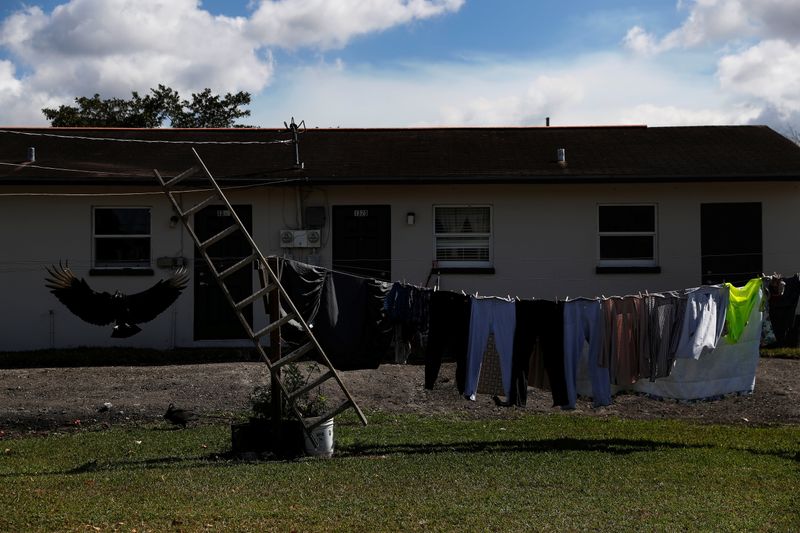WASHINGTON (Reuters) – U.S. homebuilding dropped to a six-month low in February as severe cold gripped many parts of the country, in a temporary setback for a housing market that remains supported by extremely lean inventories amid strong demand for larger homes.
The report from the Commerce Department on Wednesday also showed a sharp decline in building permits last month. It followed on the heels of data this week showing that the deep freeze, which was most severe in Texas and other parts of the densely populated South region, depressed retail sales and output at factories.
Though the second straight monthly decline in homebuilding could lead economists to trim their lofty gross domestic product estimates for the first quarter, a rebound in starts is expected in the April-June period, keeping intact predictions that economic growth this year will be the strongest since 1984.
Indeed, the Federal Reserve on Wednesday projected robust growth and higher inflation this year. The U.S. central bank, however, repeated its pledge to keep its benchmark overnight interest rate near zero for years to come.
“We can read nothing into the underlying strength of the economy from these weather-distorted reports,” said Conrad DeQuadros, senior economic advisor at Brean Capital in New York. “March data are likely to show strong bounce backs in consumer spending, industrial production and construction activity.”
Housing starts fell 10.3% to a seasonally adjusted annual rate of 1.421 million units last month, the lowest level since last August. Economists polled by Reuters had forecast starts would decrease to a rate of 1.560 million units in February.
Starts were down 9.3% on a year-on-year basis in February.
Groundbreaking activity plunged in the Northeast, Midwest and South, but surged in the West. Permits for future home building tumbled 10.8% to a rate of 1.682 million units last month. They, however, jumped 17.0% compared to February 2020, underscoring the housing market’s strength.
U.S. stocks pared losses following the Fed statement. The dollar edged down versus a basket of currencies. Longer-dated U.S. Treasury yields were higher. (Graphic: Housing starts and building permits, https://graphics.reuters.com/USA-STOCKS/bdwpkmzkypm/hsbp.png)
RISING CHALLENGES
The year-long COVID-19 pandemic has shifted demand towards bigger and more expensive houses as millions of Americans continue to work from home and remote schooling remains in place.
But challenges for the housing market, one of the main drivers of the economic recovery, are mounting. The 30-year fixed-rate mortgage has risen to an eight-month high of 3.05%, according to data from mortgage finance agency Freddie Mac.
Mortgage rates have jumped in tandem with Treasury yields, which have spiked as investors anticipate that stronger growth will generate significant inflation. Growth is being driven by massive fiscal stimulus, including President Joe Biden’s $1.9 trillion rescue package, which was enacted last week.
A separate report from the Mortgage Bankers Association on Wednesday showed a moderate increase in applications for loans to purchase a home last week. Though mortgage rates remain low by historical standards, they are contributing to the rising costs of homeownership, especially for first-time buyers.
Supply disruptions because of coronavirus-related restrictions are driving up commodity prices, including softwood lumber, which surged a record 79.7% in February on a year-on-year basis. According to a survey from the Associated General Contractors of America, manufacturers have hiked drywall prices by 20% effective late March or the beginning of April.
A survey on Tuesday showed confidence among single-family homebuilders dipped in March, despite strong buyer traffic, amid worries over rising material costs and delivery times, especially for softwood lumber.
With the supply of previously owned homes at record low levels, builders are likely to continue breaking more ground, though houses could become more expensive.
“Builders face some near-term challenges,” said Ryan Sweet, a senior economist at Moody’s Analytics in West Chester, Pennsylvania. “We don’t anticipate that this will weigh too heavily on starts, the forecast is for housing starts to steadily increase throughout the course of this year.”
Single-family homebuilding, the largest share of the housing market, declined 8.5% to a rate of 1.040 million units in February, also a six-month low. Single-family building permits tumbled 10.0% to a rate of 1.143 million units.
Starts for the volatile multi-family segment plunged 15.0% to a pace of 381,000 units. Building permits for multi-family housing projects declined 12.5% to a pace of 539,000 units.
Housing completions jumped 2.9% to a rate of 1.362 million units last month. Realtors estimate that housing starts and completion rates need to be in a range of 1.5 million to 1.6 million units per month to close the inventory gap.
The stock of housing under construction rose 0.3% to a rate of 1.283 million units, the highest level since October 2006.
“Builders will continue to have a key role to play in addressing the inventory shortage for a market chock full of eager home shoppers,” said Matthew Speakman, an economist at Zillow. “The homebuilding sector has more room to run.”
(Reporting by Lucia Mutikani; Editing by Paul Simao and Andrea Ricci)





















